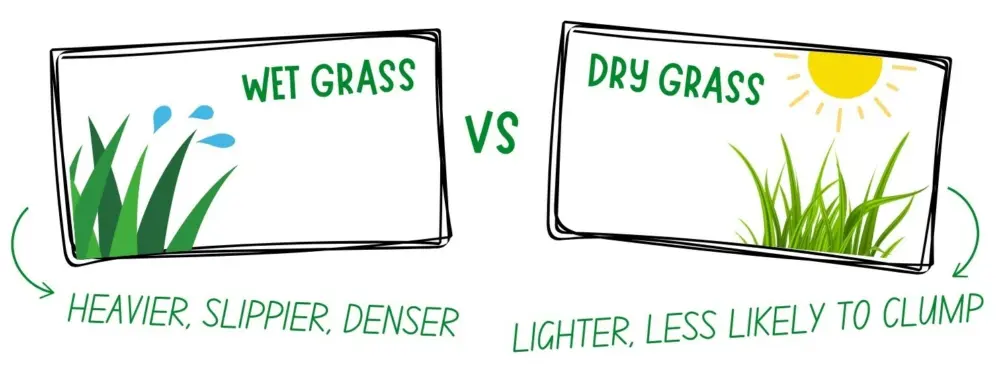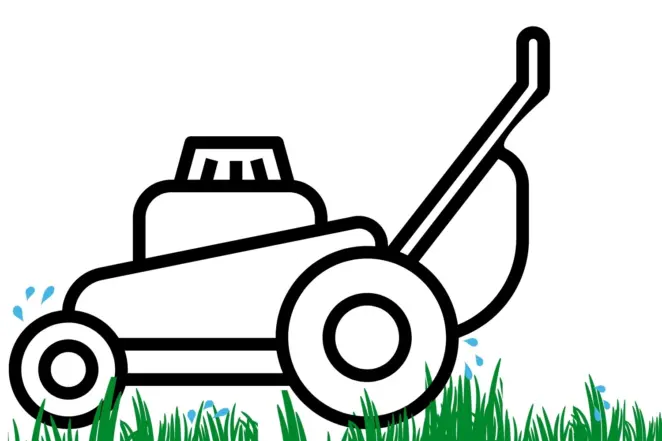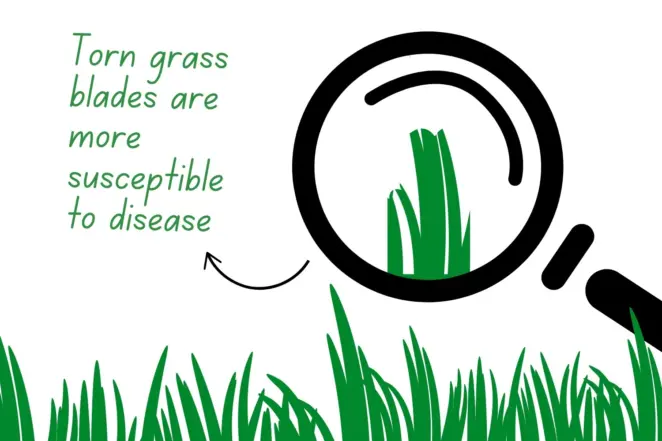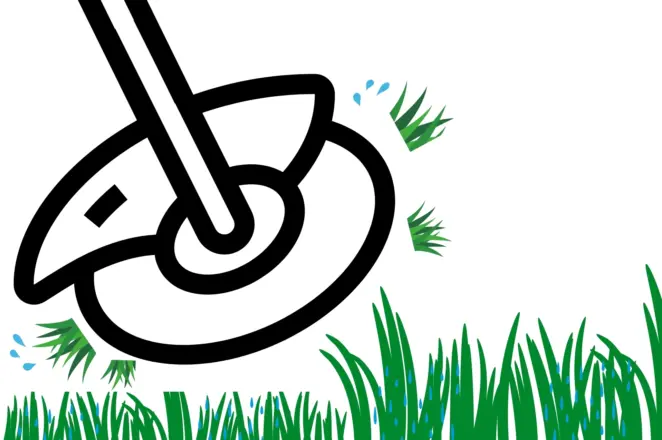Can You Cut Wet Grass?
Can you cut wet grass? It’s a question many homeowners find themselves asking, especially in rainy seasons like March / April when you want to give your lawn a mow ready for summer but just can’t get a dry day to do it.
If you’re thinking about cutting wet grass, you should ideally wait until your lawn is dry. While it’s possible to mow your wet lawn, it could damage your grass, break your mower and, frankly, won’t produce the best results.
Why Can’t I Cut Wet Grass?
Wet, damp grass is heavier and more resilient than dry grass, meaning it’s a lot harder to mow.
The wet blades of grass are more likely to stick and clump together when mowed, compared to the light, dispersed dry grass clippings.
If you try to mow your lawn when wet, it can potentially damage both your grass blades and your mower, so it's usually best to wait until the lawn is dry.


Damage to Grass
The heavy weight of the mower on wet grass can potentially compact your soil, limiting airflow to the ground and affecting the drainage on your lawn. This can contribute to waterlogging and stunted root growth.
Mowing wet grass usually produces uneven results as, with the grass being denser, the mower must use more power to get a clean cut which isn’t easy to do with weighty, tougher grass.
Your mower may struggle to get a grip on the wet grass and, instead of giving you a nice, clean cut, can rip or tear your grass blades. Not only does this produce uneven results but torn / damaged grass blades make for an unhappy and unhealthy lawn.
Cutting wet grass can weaken your grass blades over time, reducing the durability of the lawn and making it more vulnerable to disease.
It also puts your lawn at risk from further damage from mowing or adverse weather conditions. This weakness, combined with damp conditions, allows lawn diseases like red thread or snow mould (fusarium patch) to thrive.
These two diseases are common in mild, wet seasons like autumn and winter and can take hold easily if your grass is too stressed or weak to fight off the disease.

What if I Have to Cut Wet Grass?
Whilst we don’t recommend mowing grass when it’s wet, sometimes (especially in standard soggy British weather) that doesn’t always go to plan.
Whether you’ve got an event coming up or the grass simply must be cut and it’s not been dry for days, there are certain situations where you may feel like you have no option but to cut your grass when it’s wet.
We’d always recommend checking local weather forecasts to try and time your mowing schedule around dry periods, but if it doesn’t go to plan, you can mow wet grass safely and carefully for the best results:
How To Cut Wet Grass:
- Use a high-powered mower that has the strength to cut through more resilient grass. The mower should be in the best condition possible with clean, sharp blades to cut through the grass with ease. Blunt mower blades can rip or tear your grass blades, so, especially for heavier grass, having a sharp blade is key for a clean cut. However, over sharpening your mower blades can make them brittle and more likely to break if they encounter any debris like rocks or sticks.
- Use a battery powered motor. Cutting wet grass can put more strain on the mower’s motor, so, if you must cut wet grass, we’d recommend using a strong battery-powered motor, rather than an electrical one. Electric mowers are not designed for use in the rain and is potentially dangerous - electricity and water famously don’t mix well. Although electric mowers can cut damp grass, it should be avoided, and most manufacturers recommend you wait until the grass has dried properly to mow.
- Mow slowly and carefully- avoid overloading the mower with lots of clippings and take your time to clear any clumps or clogs that form in the blades and deck as you go along. The faster and more haphazardly you mow, the more risk of tearing or damaging your grass there is. You should not mulch your clippings as this can smother the lawn and limit airflow to the ground. Instead, you should bag them and dispose of them in your garden waste bin or add to a compost pile.
- Raise your mowing height for a wet mow. Taking a smaller amount of height off is a lot easier for mowers to handle in wet conditions, rather than trying to cut through substantial, heavy length. You also then minimise the risk of your mower blades scalping your lawn.
- Wear correct footwear with adequate grip to avoid any slips, trips or falls on wet ground. Shoes with non-slip soles with good traction are ideal, though be aware that wet grass clippings may stain shoes!
- Clean your mower after every use and give it a deep clean before you put it away for winter. This makes sure it’s in good condition for future mows or to sit dormant ready for when spring rolls back around. A well-maintained mower means it’s less likely to break in the long run and produce better results if it stays clean and healthy. Maintaining it as little and often as possible means you won’t have to do big repair jobs in the long run, too.
Damage to Mower
Mowing wet grass makes for an unhappy mower – wet grass clippings clump together more easily and are prone to clogging the mower deck and blades.
Therefore, not only will you need to take more time when mowing to clear the deck regularly but, if these clippings are left to solidify and not removed properly after mowing, they can cement to the deck and be extremely difficult to remove once dry.

In worst cases, you may have to use a wire brush or scraper to remove the cemented grass, but you then risk damaging the mower deck or scratching the paint, which can rust if you’re then continuing to mow in wet conditions.
As wet grass is denser, it takes more effort from your mower to cut, putting extra strain on the motor. Combined with potential clogging from wet clippings, your mower’s engine will have to work twice as hard. This can lead to overheating and possible engine failure, meaning you’ll need to replace your mower more often.
How to Cut Wet Grass Safely
Use a high-powered mower that has the strength to cut through more resilient grass. The mower should be in the best condition possible with clean. sharp blades to cut through the grass with ease. We'd advise trying to use a battery powered mower rather than an electrical one to minimise the risk of any short circuits or shocks. Electric mowers are not designed for use in the rain and this is potentially dangerous - electricity and water famously don't mix well. Although electric mowers can cut damp grass this should also be avoided and most manufacturers recommend you wait until the grass has dried properly.
Mow slowly and carefully- avoid overloading the mower with lots of clippings and take your time to clear any clumps or clogs that form in the blades and deck as you go along. The faster and more haphazardly you go, the more risk of tearing or damaging your grass there is.
Raise your mowing height for a wet mow. Taking a smaller amount of height off is a lot easier for mowers to handle in wet conditions, rather than trying to cut through substantial, heavy length.
Wear correct footwear with adequate grip to avoid any slips, trips or falls on wet ground. Be aware that cut wet grass may stain shoes.
When in doubt, it’s always best to wait until your grass is dry to mow your lawn, but by following the best practises to mow wet grass safely, you have the best chance for an even and satisfactory cut.

If you’re not confident about how your mower is going to fare when trying to cut wet grass, then a popular alternative is using a strimmer to quickly knock a bit of the length off without having to use a heavy-duty mower.
Strimmers can handle tall, overgrown areas better than standard mowers and tend not to clog as easily when it comes to wet grass.
However, they can produce uneven and patchy results as (depending on which way you tilt the strimmer) they can give you inconsistent cutting heights, so they rely strongly on your personal hand-eye coordination for even, clean results.
It's also easier to accidentally scalp a lawn when using a strimmer as it cannot be set to a consistent mowing height and can accidentally cut areas too short.
For the best results, you should swing the strimmer in a smooth, sweeping motion to get the most even, consistent cut. You can also use it to messily knock a small amount of length off and then mow after for a finished, clean cut. That way, your mower will be more equipped to handle a smaller amount / length of wet grass.
When in doubt, it’s always best to wait until your grass is dry to mow your lawn, but by following the best practises to mow wet grass safely, you have the best chance for an even and satisfactory cut.
For more helpful tips, follow our lawn mowing and seasonal lawn care guides.
Have a specific question about cutting your grass when it’s wet? Get in touch and we’ll be able to provide tailored advice.


